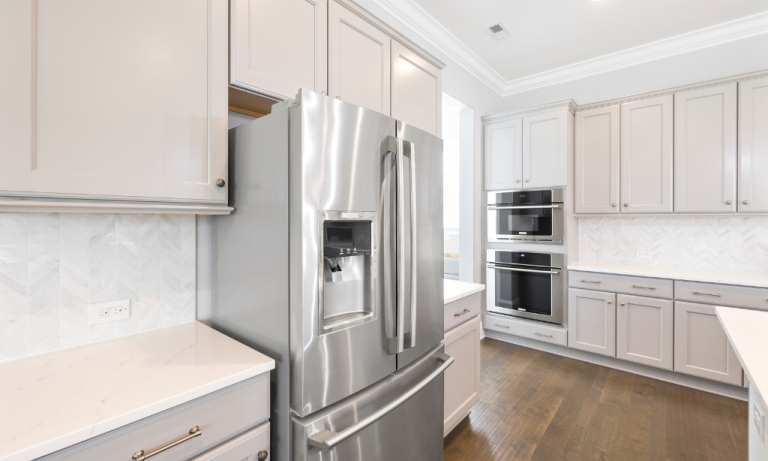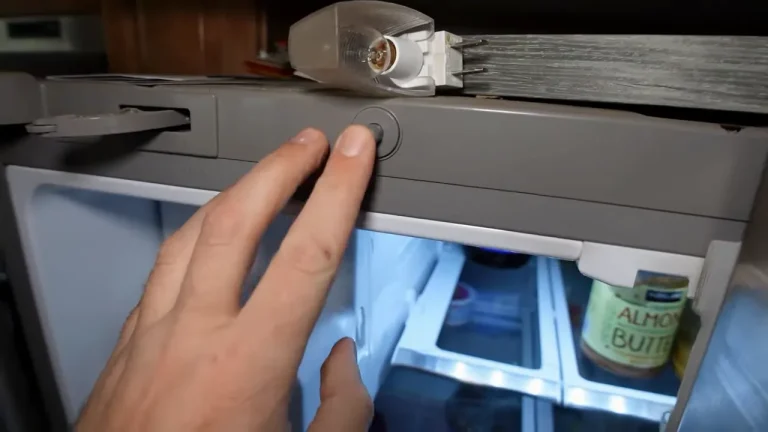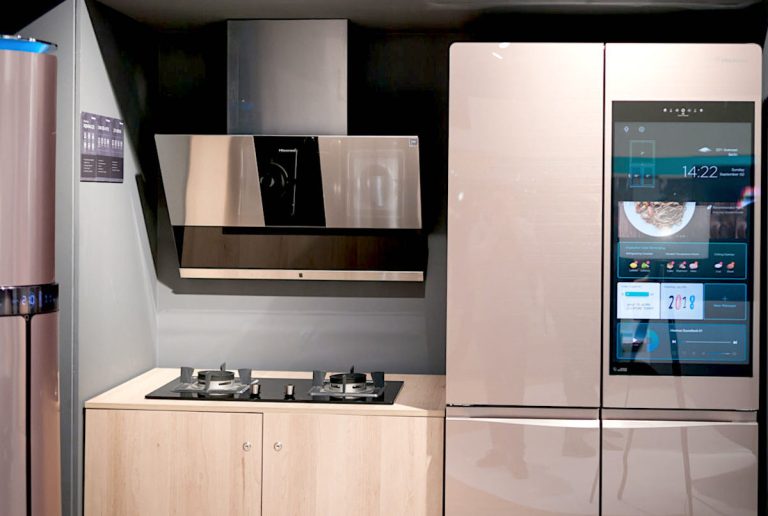GE Profile Refrigerator Troubleshooting Water Dispenser [2024]
An essential component of modern kitchen appliances, the GE Profile Refrigerator stands as a testament to innovation and convenience. Among its myriad features, the water dispenser takes center stage, offering a refreshing and readily accessible source of hydration. However, even the most advanced appliances may encounter issues over time.
In this troubleshooting guide, we will navigate through common challenges faced by GE Profile Refrigerator water dispensers, providing insights and solutions to ensure that your appliance continues to deliver chilled, crystal-clear water effortlessly.
From understanding potential causes to implementing practical fixes, this article aims to empower users to maintain peak performance and reliability in their GE Profile Refrigerator water dispensers.
GE Profile Refrigerator Water Dispenser Problems for Troubleshooting
1. GE Profile Refrigerator Water Dispenser Not Working But Ice Maker Is
Imagine the frustration of reaching for a cool glass of water from your GE Profile Refrigerator only to find that the water dispenser is not working, while the ice maker functions flawlessly. While this issue may seem perplexing, there are several potential causes and straightforward fixes to get your water dispenser back in action.
Possible Causes:
- Water Supply Issues: Ensure that the water supply to the refrigerator is turned on.
- Check for any kinks or blockages in the water supply line.
- Air in the Water Line: New installations or filter replacements may introduce air into the water line, causing a temporary blockage.
- Frozen Water Reservoir: Extremely low temperatures in the refrigerator may lead to the freezing of the water reservoir, impeding water flow.
Fixes:
Verify Water Supply:
Confirm that the water supply valve, usually located behind the refrigerator, is fully open.
Inspect the water line for any visible kinks or obstructions. Straighten or clear them as needed.
Purge Air from the Water Line:
Dispense water for a few minutes to purge any air trapped in the water line.
If the refrigerator has a water filter, ensure it is properly installed and bled according to the manufacturer’s instructions.
Thaw Frozen Water Reservoir: Temporarily adjust the refrigerator temperature to a milder setting to thaw a frozen water reservoir.
After thawing, restore the temperature settings to the desired levels.
2. Water Dispenser Keeps Freezing
Encountering a scenario where your GE Profile Refrigerator’s water dispenser consistently freezes can be both perplexing and inconvenient. When this issue arises, it not only disrupts the smooth operation of the dispenser but also raises concerns about the overall performance of the appliance. Fortunately, there are specific causes and practical solutions to address the problem of a water dispenser that keeps freezing.
Possible Causes:
- Temperature Settings: Inadequate temperature settings within the refrigerator or freezer compartments may cause water in the dispenser line to freeze.
- Faulty Door Seal: A compromised door seal can lead to the infiltration of warm air into the dispenser area, causing condensation that later freezes.
- Defective Water Inlet Valve: A malfunctioning water inlet valve may result in excessive water flow, leading to frozen water in the dispenser.
Fixes:
- Adjust Temperature Settings: Check and adjust the temperature settings in both the refrigerator and freezer compartments. Ensure they are within the recommended range specified in the user manual.
- Inspect and Seal Door Gasket: Examine the door gasket for any visible wear, tears, or gaps. A faulty gasket allows warm air to enter, leading to freezing. Replace the gasket if necessary.
- Regulate Water Inlet Valve: If the water inlet valve is suspected to be the issue, regulate its flow to ensure a controlled amount of water is dispensed. This may involve adjusting the water pressure or replacing the valve if it is faulty.
- Run the Dispenser Regularly: To prevent freezing, use the water dispenser regularly. Regular operation helps maintain water flow and prevents stagnation, reducing the likelihood of freezing.
- Warm the Surrounding Area: If the refrigerator is located in an extremely cold environment, consider improving the ambient temperature around the appliance. This can be achieved by adjusting the room temperature or relocating the refrigerator.
3. GE Profile Refrigerator Water Dispenser Won’t Stop Running
Discovering that your GE Profile Refrigerator water dispenser won’t stop running can be an alarming situation, potentially leading to water wastage and increased energy consumption. This persistent operation may result from various underlying issues, but rest assured, there are practical steps you can take to diagnose and resolve the problem.
Possible Causes:
- Sticky Dispenser Switch: A malfunctioning or sticky dispenser switch may cause it to remain engaged even when not in use.
- Faulty Water Inlet Valve: A defective water inlet valve may continuously allow water to flow into the dispenser, leading to non-stop operation.
- Incorrect Microswitch Adjustment: The microswitch, which activates when you press the dispenser lever, may be misaligned or incorrectly adjusted, causing it to stay engaged.
Fixes:
- Check Dispenser Switch: Inspect the dispenser switch for any visible damage or sticking. If the switch is sticky, cleaning it or replacing it may resolve the issue.
- Inspect Water Inlet Valve: Examine the water inlet valve for signs of leaks or malfunctions. If there are issues, replacing the valve can often rectify the problem.
- Adjust Microswitch: Carefully inspect the microswitch that is activated by the dispenser lever. Ensure it is properly aligned and not stuck in the “on” position. If misaligned, adjust or replace the microswitch as needed.
- Check for Obstructions: Inspect the dispenser lever and the surrounding area for any obstructions that may be preventing it from returning to the off position. Clear any debris or obstacles.
- Reset the Refrigerator: Some models may have a reset button. Refer to your user manual to locate and use the reset button to restore normal operation.
- Power Cycle the Refrigerator: Power off the refrigerator for a few minutes and then turn it back on. This simple reset may resolve electronic glitches causing the continuous operation.
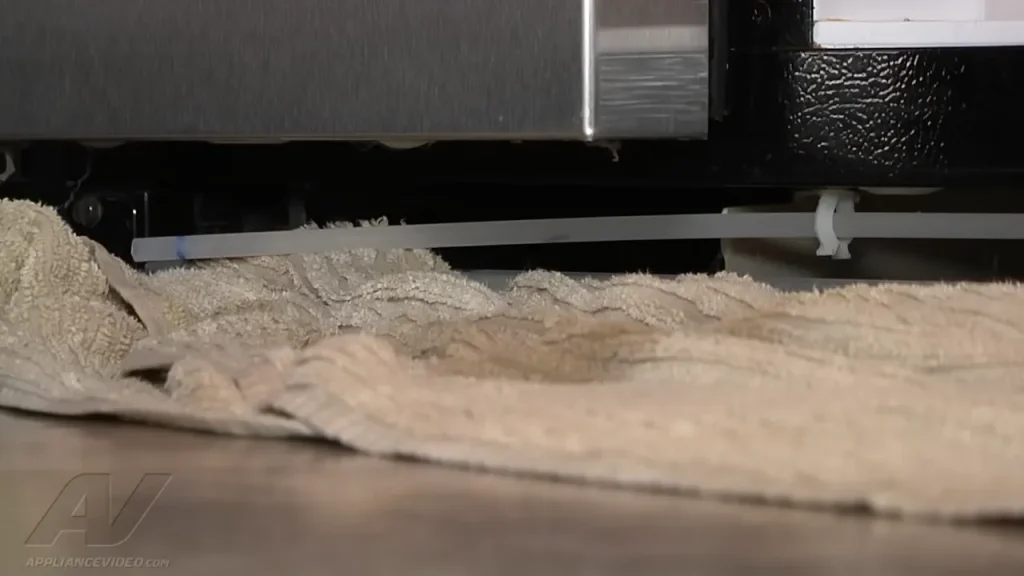
4. GE Profile Refrigerator Water Dispenser Not Working After Replacing Filter
Experiencing a situation where your GE Profile Refrigerator water dispenser stops working after replacing the water filter can be perplexing, especially when you expect an improvement in water quality and flow. However, this issue is not uncommon, and understanding the potential causes and implementing the correct solutions can help restore your water dispenser to optimal functionality.
Possible Causes:
- Air in the Water Line: Replacing the water filter can introduce air into the water line, affecting water flow and causing temporary dispenser issues.
- Incorrect Installation of the Water Filter: An improperly installed or misaligned water filter may hinder the water flow and disrupt the dispenser operation.
- Water Filter Bypass: Some refrigerator models are equipped with a water filter bypass plug that must be used when a filter is not installed. Failure to use this bypass may lead to dispenser issues.
Fixes:
- Purge Air from the Water Line: Dispense water for a few minutes to flush out any air trapped in the water line. This helps restore normal water flow after a filter replacement.
- Reinstall the Water Filter: Double-check the installation of the new water filter. Ensure it is correctly aligned and securely seated in its housing. Refer to the user manual for specific instructions on proper installation.
- Use the Water Filter Bypass :If your refrigerator model requires a water filter bypass when no filter is installed, ensure that it is in place. This bypass plug maintains proper water flow to the dispenser.
- Check for Filter Compatibility: Ensure that the replacement water filter is compatible with your specific GE Profile Refrigerator model. Using an incompatible filter may lead to dispenser issues.
- Perform a System Reset: Some refrigerators may require a system reset after a filter replacement. Refer to the user manual for instructions on how to reset the water filter indicator or the refrigerator system.
5. Water Dispenser Won’t Dispense Cold Water
Discovering that your GE Profile Refrigerator’s water dispenser won’t dispense cold water can be inconvenient, especially when you’re looking forward to a refreshing, chilled drink. Several factors may contribute to this issue, but with a systematic approach, you can identify the root cause and apply effective solutions to restore the dispenser to its optimal state.
Possible Causes:
- Inadequate Refrigerator Temperature: If the overall refrigerator temperature is too high, the water in the dispenser may not be cold enough.
- Frozen Water Reservoir or Line: Extremely low temperatures in the refrigerator may lead to the freezing of the water reservoir or dispenser line, hindering water flow.
- Faulty Water Inlet Valve: A malfunctioning water inlet valve may not allow enough cold water to reach the dispenser.
Fixes:
- Adjust Refrigerator Temperature: Check and adjust the refrigerator’s temperature settings to ensure they are within the recommended range for optimal cooling. Allow some time for the temperature to stabilize.
- Thaw Frozen Water Reservoir or Line: If the water reservoir or dispenser line is frozen, temporarily adjust the refrigerator temperature to a milder setting to facilitate thawing. Once thawed, return the temperature settings to the desired level.
- Verify Water Inlet Valve Functionality: Inspect the water inlet valve for any signs of damage or malfunction. If the valve is faulty, replacing it can restore proper water flow.
- Run the Dispenser Regularly: To prevent freezing and ensure a steady flow of cold water, use the water dispenser regularly. Regular operation helps prevent stagnation and freezing in the water line.
- Check for Obstructions: Inspect the dispenser area for any obstructions that may be hindering the flow of cold water. Clear any debris or obstacles to allow for smooth operation.
- Inspect the Water Filter: If your refrigerator has a water filter, check whether it is clogged or needs replacement. A clogged filter can impede water flow and affect the temperature of the dispensed water.

6. GE Profile Refrigerator Water and Ice Dispenser Not Working
Encountering a scenario where both the water and ice dispenser on your GE Profile Refrigerator cease to function can be a perplexing and inconvenient situation. While the simultaneous failure of both dispensers may seem daunting, there are common causes and practical fixes that can help diagnose and resolve the issue, restoring the full functionality of these essential features.
Possible Causes:
- Power Supply Issues: Check if the refrigerator is receiving power. A tripped circuit breaker or power outage can disrupt the functioning of both the water and ice dispensers.
- Frozen Water Line: Extremely low temperatures in the refrigerator or freezer can lead to the freezing of the water line, affecting both water and ice dispensing.
- Faulty Dispenser Switch: Malfunctions in the dispenser switch, which activates the dispensing process, can result in both the water and ice dispensers failing to operate.
- Water Inlet Valve Problems:A defective water inlet valve may hinder the supply of water to both the water and ice dispensers.
Fixes:
- Check Power Supply: Ensure that the refrigerator is properly plugged in and receiving power. Check the circuit breaker to confirm there are no tripped circuits. Power cycling the refrigerator may also help reset any electronic glitches.
- Thaw Frozen Water Line: If the water line is frozen, temporarily adjust the refrigerator’s temperature to a milder setting to facilitate thawing. Once thawed, return the temperature settings to the desired level.
- Inspect Dispenser Switch: Examine the dispenser switch for any visible damage or sticking. Cleaning or replacing the switch may resolve issues related to dispenser activation.
- Verify Water Inlet Valve Functionality: Inspect the water inlet valve for signs of damage or malfunction. If the valve is faulty, replacing it can restore proper water flow to both dispensers.
- Reset the Dispenser: Some refrigerator models have a reset button for the dispenser. Refer to the user manual to locate and use the reset button to restore normal operation.
- Consult Manufacturer’s Support: If the issue persists, consult the manufacturer’s troubleshooting guide or contact their customer support for further assistance. They may provide specific instructions based on your refrigerator model.
7. GE Profile Refrigerator Water Dispenser Not Working
Discovering that your GE Profile Refrigerator’s water dispenser is not working can be a frustrating experience, especially when you rely on it for convenient access to chilled water. Fortunately, many common issues leading to a non-functional water dispenser can be diagnosed and addressed with a systematic approach.
Possible Causes:
- Water Supply Issues: Ensure that the water supply to the refrigerator is turned on. Check for any kinks or blockages in the water supply line.
- Air in the Water Line: New installations or recent filter replacements can introduce air into the water line, causing a temporary blockage.
- Frozen Water Line: Extremely low temperatures in the refrigerator can lead to the freezing of the water line, impeding water flow.
- Faulty Water Inlet Valve: A malfunctioning water inlet valve may prevent water from reaching the dispenser.
Fixes:
- Verify Water Supply:
Confirm that the water supply valve, typically located behind the refrigerator, is fully open.
Inspect the water line for any visible kinks or obstructions. Straighten or clear them as needed.
- Purge Air from the Water Line:
Dispense water for a few minutes to purge any air trapped in the water line.
If your refrigerator has a water filter, ensure it is properly installed and bled according to the manufacturer’s instructions.
- Thaw Frozen Water Line: If extremely low temperatures are suspected, temporarily adjust the refrigerator temperature to a milder setting to thaw the water line. Once thawed, return the temperature settings to the desired level.
- Inspect Water Inlet Valve: Examine the water inlet valve for any signs of damage or malfunction. If necessary, replace the valve to restore proper water flow.
- Check for Obstructions: Inspect the dispenser area for any obstructions that may be hindering water flow. Clear any debris or obstacles.

8. Slow Water Dispenser
Encountering a slow water dispenser on your GE Profile Refrigerator can be a frustrating experience, especially when you’re looking for quick and efficient access to chilled water. Fortunately, there are common causes for slow water dispensing and practical fixes to address this issue.
Possible Causes:
- Clogged Water Filter: Over time, water filters can accumulate sediment and impurities, leading to reduced water flow.
- Low Water Pressure: Insufficient water pressure from the supply line can result in slow dispenser operation.
- Air in the Water Line: Air trapped in the water line can impede water flow and cause slower dispensing.
Fixes:
- Replace the Water Filter: If it has been a while since the water filter was replaced, consider installing a new one. Refer to the user manual for the recommended filter type and replacement interval.
- Check Water Pressure: Ensure that the water pressure from the supply line meets the recommended levels specified in the user manual. Low water pressure may require professional plumbing adjustments.
- Purge Air from the Water Line: Dispense water for a few minutes to flush out any air trapped in the water line. This helps restore normal water flow after a filter replacement or other disruptions.
- Inspect for Kinks or Blockages: Examine the water line for any visible kinks, twists, or blockages. Straighten or clear any obstructions that may be hindering water flow.
- Adjust Temperature Settings: Ensure that the refrigerator and freezer compartments are set to the recommended temperatures. Extremely low temperatures can cause water to freeze, affecting dispenser performance.
- Check for Water Inlet Valve Issues: Inspect the water inlet valve for any signs of damage or malfunction. If the valve is faulty, it may need to be replaced to restore proper water flow.
- Consult Manufacturer’s Support: If the issue persists despite these troubleshooting steps, it’s advisable to consult the manufacturer’s support or seek assistance from a qualified appliance technician for a thorough evaluation and repair.
9. Water Dispenser Turns On by Itself
Discovering that your GE Profile Refrigerator’s water dispenser turns on by itself can be a perplexing and potentially concerning issue. An unexpectedly activated water dispenser not only raises questions about energy efficiency but also prompts concerns about potential water wastage. Identifying the root cause and implementing appropriate fixes can help restore normal operation and prevent unnecessary resource consumption.
Possible Causes:
- Faulty Dispenser Switch: Malfunctions in the dispenser switch, which is responsible for activating and deactivating the dispenser, can lead to unintended activations.
- Electronic Glitches: An issue with the refrigerator’s electronic control board or sensors may cause the water dispenser to turn on spontaneously.
- Moisture or Contamination: Moisture or foreign substances near the dispenser controls may trigger unintended activations.
Fixes:
- Inspect Dispenser Switch: Examine the dispenser switch for any visible damage or sticking. If the switch appears to be malfunctioning, cleaning or replacing it may resolve the issue.
- Reset the Refrigerator: Power off the refrigerator for a few minutes and then turn it back on. This simple reset may address electronic glitches causing the dispenser to turn on unexpectedly.
- Check for Moisture or Contamination: Inspect the area around the dispenser controls for moisture, spills, or foreign substances. Clean and dry the area thoroughly to prevent unintended activations.
- Review User Manual: Refer to the user manual for your specific GE Profile Refrigerator model. It may provide guidance on troubleshooting unexpected dispenser activations and offer insights into potential solutions.
10. Water Dispenser Is Noisy
Experiencing an unusually noisy water dispenser on your GE Profile Refrigerator can be disruptive and concerning. The unexpected sounds may vary, including buzzing, humming, or rattling noises, but understanding the potential causes and implementing effective fixes can help restore a quieter and more enjoyable user experience.
Possible Causes:
- Water Inlet Valve Vibrations: Vibrations from the water inlet valve, responsible for controlling water flow, can generate noise if not properly secured.
- Water Pressure Issues: High water pressure in the supply line may result in vibrations and noisy operation when water is dispensed.
- Air in the Water Line: Air trapped in the water line can cause turbulence and noise during the dispensing process.
- Loose Components: Loose components in the dispenser area, such as tubing or fittings, may vibrate and produce noise.
Fixes:
- Secure the Water Inlet Valve: Check if the water inlet valve is securely mounted. If loose, tighten the mounting screws to reduce vibrations.
- Adjust Water Pressure: If the water pressure is too high, consider installing a pressure regulator in the supply line. This can help reduce vibrations and noise during dispensing.
- Purge Air from the Water Line: Dispense water for a few minutes to flush out any air trapped in the water line. This can minimize turbulence and noise caused by air bubbles.
- Inspect for Loose Components: Examine the dispenser area for any loose tubing, fittings, or components. Secure or tighten any parts that may be contributing to the noise.
- Check for Obstructions: Inspect the dispenser area for any foreign objects or obstructions that may be causing noise. Remove any debris or items that could be interfering with smooth operation.
- Review User Manual: Refer to the user manual for your specific GE Profile Refrigerator model. It may provide insights into common noise issues and offer guidance on resolving them.
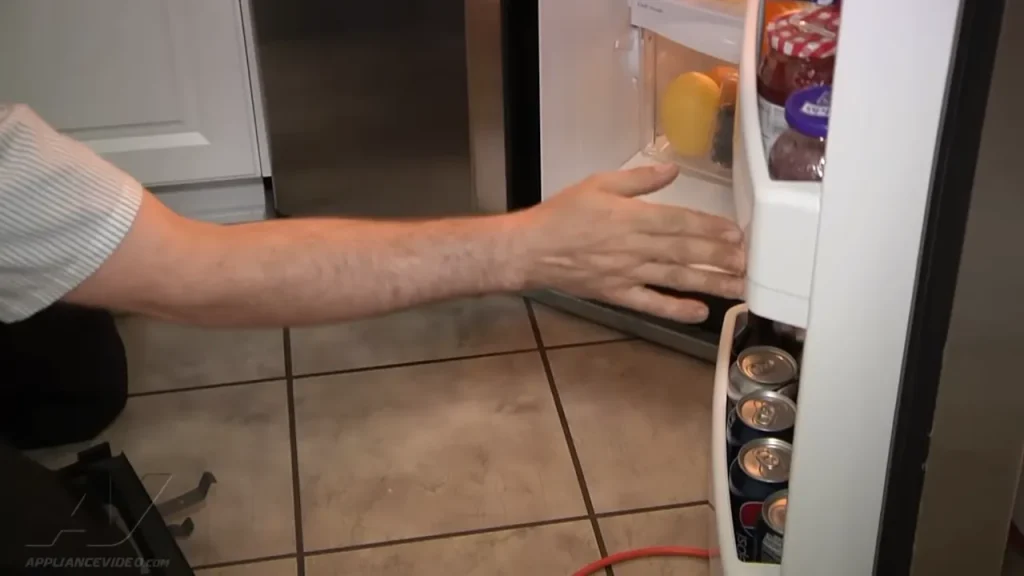
Why did my refrigerator water dispenser suddenly stop working?
There are several potential reasons why a refrigerator water dispenser may suddenly stop working. One common issue is a disruption in the water supply. Check to ensure that the water supply to the refrigerator is turned on and that there are no kinks or blockages in the water supply line.
Another possibility is a frozen water line or water reservoir, especially in environments with extremely low temperatures. Thawing the line or reservoir can often resolve this issue.
A malfunctioning water inlet valve, faulty dispenser switch, or issues with the electronic control board can contribute to the sudden cessation of water dispenser functionality. Regular maintenance, such as replacing water filters as recommended by the manufacturer, can also play a crucial role in preventing disruptions in the water dispensing system.
Why is no water coming out of my water dispenser?
The absence of water from your refrigerator’s water dispenser can be attributed to various factors. One common issue is a potential disruption in the water supply. Verify that the water supply valve, typically located behind the refrigerator, is fully open.
Check for any kinks or obstructions in the water supply line, as these can impede the water flow. Additionally, a frozen water line or reservoir, especially in colder environments, may be causing the lack of water. Adjusting the refrigerator temperature temporarily to a milder setting can help thaw the frozen components.
Another potential culprit is a clogged water filter, restricting water flow. Regularly replacing the water filter, as recommended by the manufacturer, can prevent such obstructions. If these troubleshooting steps do not resolve the issue, inspect the dispenser switch for malfunctions or consult the refrigerator’s user manual for model-specific guidance.
How do I know if my refrigerator water inlet valve is bad?
Determining whether your refrigerator’s water inlet valve is malfunctioning involves paying attention to specific signs and symptoms. One common indicator of a faulty water inlet valve is a decrease or complete cessation of water flow to the refrigerator’s dispenser or ice maker.
If you notice a significant reduction in water pressure or no water being dispensed, the water inlet valve could be the culprit. Additionally, a persistent leaking around the refrigerator or a buildup of ice in the ice maker are potential signs of a malfunctioning valve.
Unusual sounds such as buzzing or humming emanating from the back of the refrigerator may also suggest issues with the valve. It’s essential to consider these symptoms in conjunction with a thorough inspection of the water supply line and the dispenser components.
Frequently Asked Questions
Q: Why is my GE Profile refrigerator water dispenser not working at all?
A: Check if the refrigerator is connected to a water source and that the water supply valve is fully open. Also, ensure that the water filter is not clogged and needs replacement.
Q: The water from the dispenser tastes strange. What should I do?
A: Replace the water filter as it may be overdue for a change. Old filters can affect the taste and quality of the water.
Q: How often should I replace the water filter in my GE Profile refrigerator?
A: It is recommended to replace the water filter every 6 months or according to the guidelines in your refrigerator’s user manual.
Q: My water dispenser is making a loud noise when dispensing water. What could be the issue?
A: The noise may be due to air trapped in the water line. Run a few cups of water through the dispenser to flush out the air and see if the noise persists.
Q: The water dispenser is dripping water after use. How can I fix this?
A: Dripping may occur if there is residual water in the dispenser tube. Try holding a cup under the dispenser for a few seconds after releasing the lever to catch any excess water.
Q: Can I use a non-GE water filter in my GE Profile refrigerator?
A: It is recommended to use genuine GE water filters to ensure compatibility and optimal performance. Non-GE filters may not fit properly or provide the same level of filtration.
Q: The water dispenser is dispensing water slowly. What could be causing this?
A: Slow water dispensing may be due to a clogged water filter. Replace the filter and check if the flow improves. Additionally, check for kinks or restrictions in the water supply line.
Q: Is it normal for my refrigerator to dispense warm water initially?
A: Yes, if the refrigerator has been idle for a while, the water in the water lines may warm up. Allow the water to run for a few seconds until it becomes cold.
Q: The water dispenser light is not working. How can I fix it?
A: Check the power connection to the refrigerator and replace the bulb if necessary. If the light still doesn’t work, there may be an issue with the dispenser control board.
Q: Can I turn off the water dispenser on my GE Profile refrigerator?
A: Yes, most GE Profile refrigerators have a water dispenser control that allows you to turn off the water dispenser. Refer to your user manual for instructions on how to disable the dispenser if needed.
As an Amazon Associate I earn from qualifying purchases.
- Can You Put Clouds Shoes in the Washing Machine? With Tips & Tricks - April 10, 2024
- European Washing Machine vs American – History, Design, Technology - March 27, 2024
- Can You Put Boxing Gloves In The Washing Machine? – Expert Tips - March 25, 2024

![GE Profile Refrigerator Troubleshooting Water Dispenser [2024]](https://homeplacetips.com/wp-content/uploads/2023/12/GE-Refrigerator-Repair-Door-Does-Not-Dispense-Water-Saddle-Tapping-Valve-Troubleshooting_000240869.webp)
![Samsung Fridge Water Dispenser Keeps Running [Quick Fixes]](https://homeplacetips.com/wp-content/uploads/2023/10/Samsung-Fridge-Water-Dispenser-Keeps-Running-768x513.jpeg)


